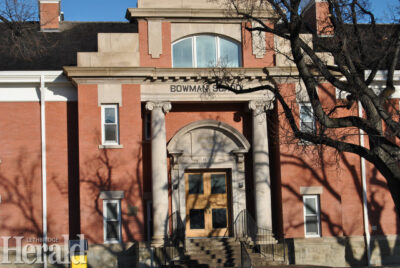Bowman should remain community resource, says Lethbridge Historical Society
By Troy Bannerman - Lethbridge Herald Local Journalism Initiative Reporter on November 24, 2022.
 The Lethbridge Historical Society would like to see the Bowman building remain a community resource. Herald photo by Troy Bannerman
The Lethbridge Historical Society would like to see the Bowman building remain a community resource. Herald photo by Troy BannermanLorien Johansen is the vice president of the Lethbridge Historical Society (LHS), and she is passionate about saving the Bowman Building located downtown across from the library and preserving its heritage as an educational institution and community resource.
“The Bowman building was officially opened in, I don’t want to quote you an exact date, but 1910,” said Johansen, describing some of the history of the building. “And it has served as many things over the years. It was a training school, which is something similar to a boarding school. One of the attendees there was from the Mars family, the owners-inventors of the Mars Bar sent their young son, their teenage son to the Bowman, to the training school there. It’s been a dance factory, it has been the library. That building is where the Lethbridge Historical Society had got its start. And it is the building where we started what is now the Galt Museum. The Galt Museum was born from the LHS in the Bowman Building. That building is very precious to both of us as organizations, and to the community at large. It has been the home of the Allied Arts Council. It has always been available to the public, in one form or another it has been available and used for members of the community. It has been owned by the city, and is currently owned by the city.”
Why is the LHS now interested in the future of this building?
The LHS keeps tabs on all the buildings and neighbourhoods of historical significance in Lethbridge. As a community resource anyone can approach them for historical information. Johansen explains that the interest in the Bowman Building right now is because it is “[a] municipal property asset at the moment. One of the reasons we are concerned is because there has been some rumblings, this last year, of the city needing to divest itself of some property. The Bowman Building ended up on the list of assets that they could sell.”
Given the history of the building and some of the current needs that our city is facing, Johansen proposes that instead of selling the building and property for redevelopment, “it should be turned into the resource hub, and the home for nonprofits, and the Indigenous community that it was planned for ten years ago. They should simply follow through on what they had promised to do. Ten years ago there was a plan created, built, drawn up, designed, put in a book, presented to the public with all of the funding, everything ready to go. That plan was to take that building and renovate it into a community resource hub. Where it has served as a school, or a museum, or all of those things, and it was going to take all of those things and split it into a co-working space where a small non-profit, such as us, or the Genealogical Society, or the Community Band Society, or any of these other nonprofits that operate in our city and provide valuable resources and information and assistance to the general public would have a home, where they could co-work.”
Johansen sees potential synergies arising from this kind of arrangement.
“So, if someone came to the Historical Society, but it needed to be at the Genealogical Society, then they could send them across the hall to the Genealogical Society. And there was also a part of that plan to give back some of that space to the Indigenous community. And offer them some of the space to set up a community resource hub for, not only Indigenous people, but for the community. So, if you wanted to learn about Indigenous people you would go to the community.”
Johansen explained why this plan was not incorporated a decade ago.
“I understand why they didn’t ten years ago. They didn’t because there was some renovations to the Courthouse and they had to move certain groups in and out while their own buildings were being renovated. So, some people moved in temporarily, and the Blast program, I think, was one that was moved in temporarily, then they moved back to their house when it was renovated. So, it has served a purpose. But it’s been sitting vacant now for a few years.”
Johansen believes the building should remain a community resource rather than being potentially sold privately.
“As a representative of the LHS, my position is that building needs to stay a community resource. It needs to be given to our Indigenous community, and to our community non-profit organizations as promised, and as a home for them to continue to serve the citizens of Lethbridge. Not only the city, but the surrounding area, the Blackfoot people, all of the people that call Lethbridge and area home, to give that building back to them as they promised to do ten years ago and never did. That is my official position as the LHS.”
12-11

